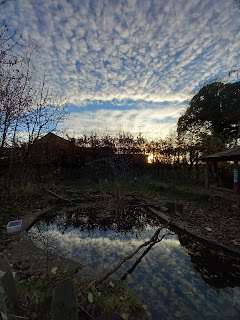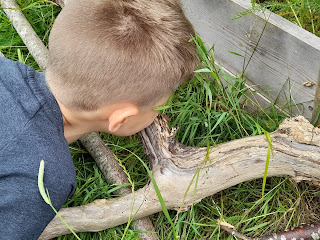The Diversity of Forest School
 As any full time Forest School establishment will tell you, you can deliver the entire curriculum outside. It takes planning and a lot of thinking outside the box, a specific way of working and all staff on board.
As any full time Forest School establishment will tell you, you can deliver the entire curriculum outside. It takes planning and a lot of thinking outside the box, a specific way of working and all staff on board. Currently still in post lockdown mode, our Forest School within a Primary, is here half to give the children the freedom that lockdown stripped them of, and half to re-activate the children's interest, innovation, resilience and problem solving skills.
In September it would be nice to think that we can all start reverting to 'normal', but that is not going to happen, and actually do we want it to?
Firstly, every year during the six weeks Summer Holiday (which is usually nearer seven for the pupils), some children move on in leaps and bounds academically and in maturity, others stagnate a little, and others revert to earlier versions of themselves.
 All the reasons for this, and all the contributing factors would fill a book not a blog, but suffice to say, those children who have been in since June 1st, AND those children who have been in all along, throughout lockdown, will return to school in different stages of development and education.
All the reasons for this, and all the contributing factors would fill a book not a blog, but suffice to say, those children who have been in since June 1st, AND those children who have been in all along, throughout lockdown, will return to school in different stages of development and education.
Then we have to consider those children who have NOT been back since lockdown started on March 23. They will have missed almost 6 months of school, the possibilities of change in their personalities, attitude to school, and learning, are in the same wide range, with a long absence making another factor for to navigate.
Finally we have no idea what the next couple of months will bring. Another national lockdown? A localised lockdown?
What changes and rearranges will be made to guidance for schools?
Can we plan now so we start the new school year with a firm idea of what we expect of 2020/2021?
What DO we expect of 2020/2021???!
I know all this sounds like I'm thinking of school only, but as our Forest School is here to enhance and support learning, the starting point has to be both what do the pupils NEED and what support can we offer?
 This week the decline in the childrens' need to rush about and expel all excess energy has diminished even more! The majority of children are looking for something to focus on beyond enjoying the freedom of movement and the energy rush.
This week the decline in the childrens' need to rush about and expel all excess energy has diminished even more! The majority of children are looking for something to focus on beyond enjoying the freedom of movement and the energy rush.We have discovered spiders who use web to weave a leaf into a tent, the baby crickets in long grass too fast to catch, red beetles , green grasshoppers and butterflies galore!
 Year 3 started making 2D art on the forest floor, a house that started singularly and became 2 'neighbours'. When Reception class ventured out they added to it and extended 'the street', including a 3D cone to make a steeple.
Year 3 started making 2D art on the forest floor, a house that started singularly and became 2 'neighbours'. When Reception class ventured out they added to it and extended 'the street', including a 3D cone to make a steeple. Our sunken tyres became a circuit that staff timed to see how quickly the children could run from one end to the other (so far 10.9 seconds is the record!). A different Reception class were fascinated by the wind making the tent billow, and it soon became a pirate ship with a plank to walk and a sea monster to slay.
And then there the rain came - and a mini mud-kitchen evolved...
Year 1 discovered Shield Bugs and that the blackberries are moving on in their life cycle, many green berries are growing larger and redder.
This week we have covered art, 2D and 3D shapes, different species, life cycles, weather, forces, PE, time, texture, viscosity, measuring, and storytelling without even trying, and all at the children's behest.
It has required curiosity, patience, imagination, fine motor skills, gross motor skills, numeracy, determination, negotiation, collaboration, and communication from them all.
What I have always wondered at is they way children who, in class, struggle to stay on focus can dedicate over an hour to a project outside, adapting it and extending it and be-moaning the winding down of time...
 This week it was 2 five-year-old's. One of which has difficulty focusing in the classroom, but joined a friend for almost an entire session making a 2D building. When his friend was too focused on his own task, instead of wandering away, he added to the scene by creating a 2D river and a bridge and a garden for the church...
This week it was 2 five-year-old's. One of which has difficulty focusing in the classroom, but joined a friend for almost an entire session making a 2D building. When his friend was too focused on his own task, instead of wandering away, he added to the scene by creating a 2D river and a bridge and a garden for the church...They discussed and added to each others ideas, worked cooperatively and independently, and added to every development, giving heartfelt praise to each other for the results.
These skills and attributes are what we all struggle to 'teach' children but so desperately want for them, and from them.
 We want independent learners who can think things through and discover their own love of learning. And we have a curriculum that adds up to a long list of facts that pupils are required to prove knowledge of. All schools struggle to meet both these needs. Covid may have inadvertently given a way in for these to merge more.
We want independent learners who can think things through and discover their own love of learning. And we have a curriculum that adds up to a long list of facts that pupils are required to prove knowledge of. All schools struggle to meet both these needs. Covid may have inadvertently given a way in for these to merge more.The use of outdoors, for literal medical safety from a virus, has given many teachers the opportunity to see how moving learning outside doesn't need to be complicated. The ongoing need to provide freedom to move and a relaxed return to school gives a chance to shift some of the curriculum outdoors permanently.
Do we grab this opportunity or sink back into the routine of the chalkface?
Of course the next challenge will be to deliver a curriculum outside!
One that integrates with classroom topics and educational requirements. These need to be bespoke to each school or setting, but could be a lot of fun to explore. Simple topics/themes that can run alongside any work prescribed by the Department of Education that will embrace the great outdoors and support learning on all levels.
That may take a while to collate.
Please feel free to join in!!
YOU NEED TO ADD HERE





Comments
Post a Comment